Welcome to the latest edition of our update on "Putin's War." It has now been 773 days since the first Russian tank rolled across the internationally recognized border between Russia and Ukraine in an unprovoked and unwarranted attack by a nuclear-armed pseudo-superpower on a much weaker neighbor.
The Russians are sticking to their narrative that the United States and Ukraine were to blame for the attack on Crocus Concert Hall.
Today’s Russian papers continue to promote the official narrative that Ukraine & the West were somehow behind the Crocus City concert hall massacre. Plus this: “Putin mustn’t stop until the axis of history has fully turned in the direction of Russian greatness.” #ReadingRussia pic.twitter.com/1DXXlmJSLt
— Steve Rosenberg (@BBCSteveR) April 2, 2024
I suppose you have to have a sneaking admiration for guys like David Sacks. It takes an immense ego to perversely stick to an untenable and rather stupid position, despite derision from all sides.
This narrative may turn out to be unique among Russian war narratives as it was obvious that not even Putin believed it, but they felt they had to press forward. It is difficult to see how this changes much of anything, given the Russians are engaged in terror attacks on Ukrainian civilians on a daily basis. What are their options for retaliation that they aren't already doing?
There was a huge kerfuffle over a statement made by Secretary of State Antony Blinken during a meeting with Ukrainian Foreign Minister Dmytro Kuleba at the NATO Foreign Ministers Meeting Thursday. "Ukraine will become a member of NATO," said Blinken, "Our purpose at the summit is to help build a bridge to that membership."
This had the usual suspects setting their hair on fire and running through the streets screaming, "Armageddon!" My colleague Bob Hoge has the details.BACKGROUND: Sec. of State Blinken Drops Eye-Opening Statement From Brussels: 'Ukraine Will Become a Member of NATO'
I've come to expect Sacks and a few others to be firmly latched onto Putin's pimply ass to get their talking points, but JD Vance is either dishonestly playing to the lowest possible denominator of the MAGA demographic, or he's too stupid to be in the Senate, and yes, given the history of that august body, that is saying something. [Full disclosure: I was a JD Vance backer in 2022.]
First, Ukraine joining NATO has been US policy for about a year. The "leaders" are the heads of state of NATO countries. This is bigger than Antony Blinken.
Finally, leaders reaffirmed that Ukraine would become a member of NATO and agreed to remove the requirement for a Membership Action Plan. "This will change Ukraine's membership path from a two-step process to a one-step process," the secretary general said. "We also made it clear that we will issue an invitation for Ukraine to join NATO when allies agree, and conditions are met."
Note the date on this tweet.
The issue of Ukraine's membership in NATO is practically resolved, NATO Secretary General Jens Stoltenberg and US Ambassador to the North Atlantic Alliance Juliana Smith said during a speech at the CNAS Center for New American Security.
— S p r i n t e r F a c t o r y (@Sprinterfactory) June 9, 2023
"The allies have repeatedly stated that… pic.twitter.com/Wn8Qt4bg1H
Second, for Ukraine to join NATO, 100 percent of the current members must approve. It took 20 months for Sweden to join due to internal opposition from Turkey and a last-ditch stand by Putin's MiniMe in Budapest. When Ukraine's membership is put to a vote, it will not be fast and will not happen unless there are government changes in Hungary and Slovakia.
Third, the constant, and I think deliberate, misstatement about what Article 5 of the North Atlantic Treaty requires shows there is more afoot, at least with guys like Vance, than meets the eye. Article 5 is the collective defense provision in the treaty. This is what it says.
The Parties agree that an armed attack against one or more of them in Europe or North America shall be considered an attack against them all and consequently they agree that, if such an armed attack occurs, each of them, in exercise of the right of individual or collective self-defence recognized by Article 51 of the Charter of the United Nations, will assist the Party or Parties so attacked by taking forthwith, individually and in concert with the other Parties, such action as it deems necessary, including the use of armed force, to restore and maintain the security of the North Atlantic area.
Note what it does not say. It doesn't require military action by any member if another member is attacked: "such action as it deems necessary, including the use of armed force." Just like Section 3 of the 14th Amendment was not "self executing," NATO's Article 5 requires affirmative action by each state before embarking on military operations. That action may be sending ammunition or allowing aircraft overflight rights.
Article 5 fearmongering is the most stupid and dishonest sort of this activity.
While fecal incontinence was the order of the day in Washington, the president of Finland was in Kiev signing a mutual security pact.
Finland just announced a new €188 million ($202 million) military aid package for Ukraine
— OSINTtechnical (@Osinttechnical) April 3, 2024
This comes as Finnish President Alexander Stubb and Ukrainian President Zelenskyi signed a bilateral security agreement between the two countries in Kyiv today. pic.twitter.com/9KyMu1Pc1B
This is the eighth such bilateral treaty between Ukraine and a NATO nation. Agreements exist with the UK, Germany, France, Denmark, Netherlands, Italy, and Canada. Spain and Greece are expected to follow soon. The US is in the process of negotiating an executive agreement guaranteeing Ukraine's security.
"We have already started bilateral consultations with your government, with the office of the president, with government agencies, and we are discussing with them what the security commitments on our part could be. So far, there have been two rounds, and the talks will continue: the Biden administration seeks this agreement."
With negotiations ongoing, Brink did not disclose the general structure or potential content of the future agreement. She did, however, emphasise that the US supports NATO membership for Ukraine, and that the security agreement serves as a "bridge to ensure security" until that happens.
"The G7 announced support for security guarantees, bilateral and multilateral, that will be such a bridge," she recalled.
The G7 entered into a mutual security pact with Ukraine in 2023. Since then, Poland and Romania have signed on.
BACKGROUND:
NATO Summit Highlights NATO Unity in Ukraine but Also Reveals Divisions
Putin's War, Week 100. Missing Prisoners, Hungary on the Hotspot, and Shell Hunger Returns
Even Ted Cruz has spoken on the subject.
Senator Ted Cruz: Based on the Budapest Memorandum, the USA has an obligation to help 🇺🇦 militarily.
— Tetiana Fella 🇺🇦 (@Tetiana_UK_) April 3, 2024
Ukraine gave up the world's third-largest nuclear weapons stockpile (~4155 nuclear warheads), ~100 strategic bombers, 176 missile complexes in exchange for safety.#ArmUkraineNow pic.twitter.com/i5zVEOL4g7
I would remind everyone that all of this has taken place without World War III scare-porn, and if Ukraine were a member of NATO today, there is no obligation that any nation do more than it is doing right now.
As all of this is happening, the foreign ministers of Germany, Poland, and France released a statement saying that NATO's 2 percent of GDP goal for defense spending is insufficient.
At some point, I think it will be safe to admit that it is Putin's rapaciousness and not fear of Trump that has driven NATO upgrades in spending and equipment. Probably just not yet.
Meanwhile, the Biden national security team never misses an opportunity to be strategically incoherent. In the last update, I posted about Jake Sullivan and his merry midwits discouraging Ukraine from striking targets inside Russia. This was in the context of Ukraine's campaign against Russian oil refineries.
BACKGROUND:
Putin's War, Week 109. Russian Offensive Jammed Up While Ukraine Funding Logjam Breaks
White House Tells Ukraine to Stop Attacking Russian Oil Refineries
This objection has been reiterated by no less than our secretary of state.
❗The USA does not support Ukraine's strikes inside the russian federation, - US Secretary of State Blinken, commenting on the strikes on the 🇷🇺refineries🙃
— Азов South (@Azovsouth) April 2, 2024
Your comments.?....? pic.twitter.com/oAkvi2FUHf
Here is the US Ambassador to NATO, Juliana Smith, on the subject.
In terms of actually going after targets inside Russia, that is something that the United States is not particularly supportive of. We are focused on Ukrainians’ right to defend its territory and to push Russians out of its territory, where the Ukrainians have had considerable success. And again, our objective is to help them continue to see those victories on the battlefield.
To the guy in the comments who claimed the story had been debunked...I'll accept your apology.
I try not to cover internal Ukrainian politics. While it is easier to write about stuff you don't understand, on the other hand, you look stupid, but clicks are clicks, amirite?
As I noted last week, Ukraine has been trying to create a new conscription law to boost the number of soldiers in the Ukrainian military. This is the point of view pushed by the former Ukrainian commander-in-chief. Working against that is the need for workers to keep the economy functioning. This is the point of view pushed by the Ukrainian business sector. After a couple of years of bickering, a law has passed. The three big changes are that it drops the minimum age for draft eligibility from 27 to 25, it makes physical qualification binary by getting rid of the "partially eligible" category, and it starts the process of developing a coherent and disciplined system for manning the force by creating a database of Ukrainian men starting at age 17.
Ukraine's president, Volodymyr Zelensky, on Tuesday lowered the draft age to 25. The move — a politically fraught measure that he had delayed signing in hopes that it would not be needed — aims to replenish the country's army amid Russia’s assault. https://t.co/a8scM0wYsF
— The New York Times (@nytimes) April 3, 2024
The former commander-in-chief had called for the mobilization of 500,000 men. Thankfully, that seems to be off the table. I have no idea how anyone thought that training, equipping, supplying, and effectively using 500k new soldiers was possible, much less a good idea. I offer the same critique of Russia's mobilization process.
Here are some of my past updates.
Putin's War, Week 109. Russian Offensive Jammed Up While Ukraine Funding Logjam Breaks
Putin's War, Week 108. Moscow Under Attack and Congress's Struggles Continue
Putin's War, Week 105. Sweden Prepares to Be Heard
Putin's War, Week 104. Second Anniversary of the 72-Hour Special Military Operation
Putin's War, Week 103. Avdiivka Abandoned
Putin's War, Week 102. Zaluzhny Is Out, Syrsky Is In, and the Ukraine Aid Bill Advances
Putin's War, Week 100. Missing Prisoners, Hungary on the Hotspot, and Shell Hunger Returns
For all my Ukraine War coverage, click here.
Politico-Strategic Level
Interview With Commander-in-Chief Oleksandr Syrskyi
One wouldn't expect to learn a lot from an interview with a senior general during a time of war. Syrskyi does offer some insights that run against familiar narratives. For instance, Ukrainian enlistees aren't sent to the front lines. They go through a basic training program. I think we all knew that and saw it documented over the last year, but pro-Russian accounts love to push the story of Ukrainian troops being treated in the same way Russian troops are.
Rotation of units for rest is emphasized, as is the need to build fortifications. We'll see how all this plays out, but if it happens, it may be because the last guy was making bad decisions and blaming others.
Trust me, I Pinky-Swear
Russian Defense Minister Sergei "the Plywood Marshall" Shoigu is promising men about to be called up in Russia's biennial draft that they won't be sent to Ukraine.
TASS: "Trust me!"
— OSINT (Uri) 🇺🇸 🇨🇦 🇬🇧 🇺🇦 🇮🇱 (@UKikaski) April 2, 2024
Shoigu: "Conscripts will not be involved in participating in a special military operation, Shoigu emphasized."
In Russia, if everyone in the Kremlin is repeating the same thing over and over, its a lie. And, in this case, a sinical lie designed to prevent… pic.twitter.com/I0ShfMPaAv
It is doubtful that this is the truth. Ever since Russia annexed the Ukrainian territories where the fighting is taking place, making them part of Russia, it has been legal to send conscripts into combat there. It is very doubtful that there are enough volunteers or prisoners to fill the ranks. Ultimately, the men called up this year will end up fighting in Ukraine.
Russian Influence Operation Exposed
Politico Europe reports that a joint Belgian-Czech investigation has exposed a Russian influence operation involving payola to European Parliament members to push Russian narratives and talking points. Totally unrelated to the story, I wonder what Mick Wallace and Clare Daly are doing today. I wish the FBI had the ambition to stop chasing jaywalkers from January 6 and do something similar.
Probably Ain't Happening
Dmitry Medvedev's Foreign Ministry has demanded the Ukrainians arrest and extradite Vasily Malyuk for the Crocus Concert Hall attack. Malyuk is the head of the SBU, the direct action arm of Ukraine's Military Intelligence Service.
Well, no surprises here. Evidence will not be provided of course, and taking into account the style of interrogation of suspected terrorists, one can assume that they confessed to everything, including that Malyuk personally deposited cryptocurrencies into their wallets. pic.twitter.com/wVnSmo2SQT
— WarTranslated (Dmitri) (@wartranslated) March 31, 2024
Ukraine's Black Sea Grain Trade Expands
A year ago, Ukraine needed Russia's permission through the good offices of Turkey to export grain. Now, Black Sea traffic bound for Russia is seeing insurance rates skyrocket, and Ukraine's Danube ports are open for business.
SAFE PASSAGE: Ukraine exported 11.8 million tons of cargo in March, worth >$ 3.2 billion. This freedom of navigation was made possible by UKR's functional defeat of Russia's navy in the western Black Sea. https://t.co/CpXs8WU5gZ
— Chuck Pfarrer | Indications & Warnings | (@ChuckPfarrer) April 1, 2024
Attacks on Ukrainian Hydroelectric Plants Continue
About 11 percent of Ukraine's electrical generation capacity has been destroyed or damaged. The focus of the Russian missile attacks has been on hydroelectric plants.
Electrical generation is a legitimate military target, as are dams.
It will be interesting to see if Ukraine launches a retaliatory campaign against Russia's much more dispersed and mostly undefended power grid.
Poland Agrees to Aid Ukraine to Restore Electrical Grid
The relationship between Poland and Ukraine isn't always the best, but the leaders have done a magnificent job of looking past grievances and fostering cooperation.
Poland announced Friday that it has signed an agreement on Polish-Ukrainian cooperation in the field of energy. Polish institutions will help Ukrainian colleagues rebuild energy infrastructure destroyed by Russians
— Intermarium 24 (@intermarium24) April 1, 2024
Russian LNG Plants Cut Production
Russian liquid natural gas plants are scaling back on production. Not from fear of Ukrainian drones or out of some devilish scheme to raise prices, but because US and EU sanctions have finally gotten their crap together, and they are hurting the export market for Russian gas. Gas storage facilities are full, but customers are getting harder to find, as are ship owners willing to carry the cargo. The result is that production has stopped.
Russia's new LNG plant cuts production as US sanctions delay exports 🇷🇺🥊🇺🇸
— Stephen Stapczynski (@SStapczynski) April 2, 2024
🚢 Arctic LNG 2 began production in Dec., but sharply reduced gas output in Feb. after storage ran out
👉 While shipments were supposed to start in 1Q, nothing has been exportedhttps://t.co/q6TnSehSl4 pic.twitter.com/PNJMMK0bVM
In #Russia, Novatek, Russia’s largest producer of liquefied natural gas (LNG), has suspended production at its Arctic LNG 2 project due to #sanctions and a shortage of gas tankers.
— Alex Kokcharov (@AlexKokcharov) April 2, 2024
Sanctions work.https://t.co/z6kzAqCriW
Sauce For the Goose is Sauce For the Gander
One of Putin's operating principles is that Russia is the guarantor of rights for Russian citizens no matter where they are. It's not entirely his idea. Boris Yeltsin used this theory as the rationale for Russia intervening in Moldova to create the AstroTurf statelet of Transnistria.
As tensions increase in Moldova with Transnistria begging for the Kremlin's help, Romania announced that it had a dog in the fight.
BREAKING: New law in Romanian parliament - the military will come to aid Romanian citizens abroad which find themselves in danger.
— Dacian Draco🇷🇴🇪🇺 (@RealDacianDraco) April 2, 2024
(In Moldova 53% have Romanian citizenship, including all the government & the president)
The risk of messing around with Moldova changed today🇲🇩🇷🇴 pic.twitter.com/pn9dQLRIUb
This opens the door to direct Romanian involvement in any Russian adventurism in Moldova and set the stage for the demolition of the Transnistria state.
Good News for Occupied Ukraine
Russian President Putin said that by 2030, Russia-occupied parts of Ukraine in Donetsk, Luhansk, Kherson and Zaporizhzhia Oblast are set to reach the "standard Russian level in key indicators of people’s quality of life and socio-economic development." pic.twitter.com/HhD1WIBpoM
— Status-6 (Military & Conflict News) (@Archer83Able) April 3, 2024
Of course, to do that, they have to give up indoor plumbing, become chronic alcoholics, and get AIDS.
Western Surgeons Assist Ukrainian Wounded
On 2 April, 12 leading US surgeons came to Lviv with a unique mission to perform complex surgeries and provide consultations to Ukrainians affected by war
— Euromaidan Press (@EuromaidanPress) April 3, 2024
This mission involves neurosurgeons, neurologists, anesthesiologists, & surgical nurses from the US https://t.co/HQqGVtLkf6
Dignified Transfer of Remains — Russian Style
Putin's bloody harvest in Bashkortostan, Russia. They could be just living their lives. But instead, they went straight into the meatgrinder, and not even Elon Musk cares about them. pic.twitter.com/svZly7RtPC
— WarTranslated (Dmitri) (@wartranslated) April 3, 2024
This is a Mystery
Two years on, the consequences of Putin’s invasion are showing.
— Ministry of Defence 🇬🇧 (@DefenceHQ) April 2, 2024
Since 2023, there's been a record 30% increase in Russian men aged 31-59 with disabilities.
Russian demographers claim the increase is most likely due to the growth in military casualties following the invasion. pic.twitter.com/uYejZXcPsl
Operational Level
The lull of last week ended rather abruptly with a major Russian push in Donbas. It started on March 31 and seems to have come to an operational pause a week later without leaving the Russians much to show for it other than dead troops and burned-out tracks. The attacks occurred all along the front, but the hammer fell in two places. In the north, it hit the village of Tonenke, which is at the northern shoulder of the now-collapsed Avdiivka Salient. In the south, it fell on the unpronounceable burg of Novomykhailivka. Since Saturday, there have been about seven battalion-sized attacks. This is the overview.
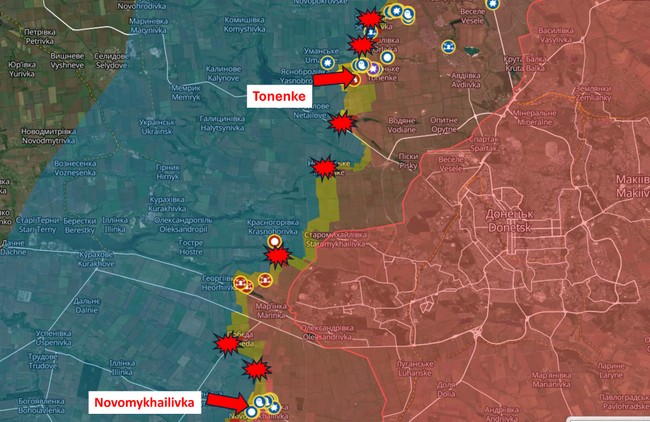 CREDIT: Base map via Andrew Perpetua, additional graphics and labels by author.
CREDIT: Base map via Andrew Perpetua, additional graphics and labels by author.
Tonenke
The Russians attacked with 36 tanks and eight armored fighting vehicles. Ukrainian reconnaissance drones documented the assault.
Footage of yesterday's Russian mechanized attack near Tonen'ke appeared. Units of the 25th Airborne Brigade managed to repel this attack and destroy up to 20 armored vehicles and tanks. pic.twitter.com/xRruVDQMtg
— NOELREPORTS 🇪🇺 🇺🇦 (@NOELreports) April 1, 2024
Eventually, the Russians reached close combat range. At 0:45 in this video, you can see Ukrainian dismounted infantry and a Russian vehicle engaged at point-blank range by some sort of anti-tank rocket.
More footage from the same Russian mechanized attack near Tonen'ke in which the 68th Separate Jaeger Brigade took part in repelling the attack. Several ATGM hits are visible. https://t.co/iDXmb25F55 pic.twitter.com/go9lWvaKJw
— NOELREPORTS 🇪🇺 🇺🇦 (@NOELreports) April 2, 2024
At least 12 tanks and eight armored fighting vehicles were destroyed before the attack halted.
The image in this tweet (or "X" post or whatever) shows the placement of the destroyed vehicles.
Accumulation of destroyed Russian AFVs on one of the roads on the Avdiivka front. https://t.co/iz4GlDrWLF pic.twitter.com/ojejyaO8gj
— Special Kherson Cat 🐈🇺🇦 (@bayraktar_1love) March 31, 2024
Note that Russian infantry did not dismount to try to clear Ukrainian infantry, nor did the Russians deploy out of a column formation.
Novomykhailivka
Here, the Russians attacked with eight armored fighting vehicles.
Shadow air reconnaissance unit shares footages of the destruction of the Russian AFV column near Novomykhailivkahttps://t.co/6BdZKaNtTB https://t.co/BjtGNmLubU pic.twitter.com/G7oobr8hof
— Special Kherson Cat 🐈🇺🇦 (@bayraktar_1love) April 2, 2024
One of the areas where the Russians had losses today was near #Novomykhailivka where an attempted assault was "repulsed."
— OSINT (Uri) 🇺🇸 🇨🇦 🇬🇧 🇺🇦 🇮🇱 (@UKikaski) April 1, 2024
(https://t.co/UPR5lI84KP)#OSINT #UkraineRussiaWar #UkraineWar #UkraineKrieg #Ukraine
RT Appreciated pic.twitter.com/XHSHbHeE9b
🔥 Epic detonation of an enemy BMP-2 on an anti-tank in the Novomykhailivka area of the Donetsk region#UkraineWarNews #UkraineWar #UkraineRussiaWar #RussiaIsATerroristState #RussiaIsANaziState pic.twitter.com/2HPVUMJ24p
— ⚔️ Hunter UA ✠ 🇺🇸🇺🇦 (@UaCoins) April 1, 2024
Six of the eight vehicles were destroyed before the attack ended.
Other Attacks
This is from an attack on the same day, farther north in Bakhmut. It is two armored fighting vehicles and nine or 10 men. They are hit by artillery, including DPICM.
Ukrainian cluster munitions destroying a large number of Russian armored vehicles pic.twitter.com/J3JMuu883f
— Visegrád 24 (@visegrad24) April 2, 2024
This is the aftermath of an attack in the Kharkiv sector.
If Ukraine can do this on an ammo shortage then russia is in trouble. The issue is getting resolved.
— Rocke Fella - NAFO Raccoon Spec Ops (@NAFORaccoon) April 1, 2024
May and June could be the deadliest months in this war for russia. pic.twitter.com/O3IwwpSKhc
This is from Terny in northern Donetsk. Toward the end, you can see Russian troops un-assing their vehicles and running.
#Ukraine, Donetsk front, Terny-Yampolivka sector. April 2024.
— Status-6 (Military & Conflict News) (@Archer83Able) April 3, 2024
Footage of a Russian armored force, consisting of tanks and BMPs, being stopped by Ukrainian artillery fire east of the settlement of Terny, situated west of Kreminna.
Russian crews can be seen leaving their… pic.twitter.com/EwFIkTTf5C
This is a major offensive. The coordination along the front indicates the attack was ordered from the highest command echelon. We can only guess at the goals. These could be a series of limited objective attacks probing Ukrainian reaction or a genuine attempt to achieve an operational breakthrough. Or they could be a continuation of the offensive that started in December to reach the historical boundaries of Donetsk and Luhansk. That objective was supposed to have been achieved by the time of Putin's "reelection." What makes the whole affair so curious is that, in all cases, the attacks were launched without the benefit of artillery or air support. They also took place without the mine clearing equipment that would be needed to effect a breakthrough.
We'll know in about a week if this is a sustained effort that will give the Russians time to swap out depleted units and restart operations.
While we're at it, I'd like to hit some stories that appeared and disappeared last week.
🇺🇦 Zelenskyy: Russia to mobilize 300.000 troops in June
— Euromaidan Press (@EuromaidanPress) April 3, 2024
Earlier, Russian exiled media reported that the Kremlin plans to mobilize 300,000 troops to capture 🇺🇦 Kharkiv. https://t.co/OtIa65T4Dh
As always, one has to consider the source and the target audience. The Russian attack on Kharkiv failed in the early days of the war. There is no reason to believe Russia can mass 300,000 men in that region by June. There is less reason to think they will cease operations in Donbas and shift them to a new front a couple of hundred miles. Keep in mind that massing the troops and constructing new railways to supply them would be conducted within the HIMARS range and within the range of Ukrainian strike aircraft. Plus, as I've documented, the Ukrainians have been fortifying the Kharkiv area since mid-summer 2023. This is not to say it can't happen, but it is much more likely a message to Ukraine's Western allies about the need for increased military aid than a warning of Russian intentions.
"I think we have assessed throughout the last couple of months that Russia has almost completely reconstituted militarily," Deputy Secretary of State Kurt Campbell said on Wednesday at a talk hosted by the Center for a New American Security. Campbell cofounded CNAS, a Washington-based think tank.
Charitably, this is bonkers. Campbell is alone among US intelligence and military organizations, and NATO member nations, in making this claim. I think the best way to evaluate this claim is in the context of the political fight over the $60 billion-plus Ukraine supplemental aid package that Speaker Johnson has pledged to bring up for a vote. Otherwise, Campbell needs a psychiatric intervention.
Third item.
Politico Europe ran a story headlined: Ukraine is at great risk of its front lines collapsing. The story is sourced to "high-ranking Ukrainian officers."
Is the situation they describe real or not real? I don't have any way of evaluating that. The sources are partisans of the former commander-in-chief. In my view, the story seems designed to insulate Zaluzhny from any blame if things go sideways over the next year while taking credit for identifying the problem and allowing the new Ukrainian leadership to fix things. It could also be that Zelensky correctly identified the rot of defeatism when he replaced Zaluzhny.
And there is an alternative scenario that is something very different. We know the FSB, which is responsible for intelligence operations in former Soviet republics, seems prone to telling their superiors what they want to hear. I think a lot of mishaps during Putin's invasion are most easily explainable if one assumes the FSB told Putin that the Ukrainian military would not fight and Ukrainians couldn't wait to be liberated from the Nazi regime of that Jew Zelensky. This story went to press four days after the big Russian offensive kicked off. It is safe to assume that it was in the works beforehand. What if, and stick with me here, the FSB had been hearing the same stories from the same people and told the Russian high command the Ukrainian line was about to buckle? What would you, as a Russian general, do? I think your reaction would be very much like what we've seen.
Drone Update
There were multiple new items concerning drones this week. Rather than spread them out, I decided to consolidate them.
Drones Are a National Priority
When the president of a country holds a top-level meeting to set up a drone production strategy, it is serious.
We held a nearly three-hour, highly specific meeting on drones with military and government officials.
— Volodymyr Zelenskyy / Володимир Зеленський (@ZelenskyyUa) April 1, 2024
We revised and specified production plans for all types of drones this year, including FPV, bombers, reconnaissance, and long-range drones for special missions.
We discussed… pic.twitter.com/oB9Kxq7WTN
Drone-Specific Warheads Developed
Early in the war, the only significant drone was the Bayraktar TB-2, manufactured in Turkey and used by Ukraine. It has four hardpoints and can carry laser-guided bombs or rockets. It was the Bayraktar that stacked up Russian vehicles on the road to Kiev. This was immediately followed by commercial-off-the-shelf and locally manufactured drones jury-rigged to carry hand grenades, mortar rounds, anti-tank mines, RPG rounds, etc. Now, with an emphasis on manufacturing drones for combat operations, we're seeing the development of warheads designed for drones.
Remember the videos showing the AFU using attack drones that have air-detonated charges including ones that are focused and directed? It turns out they are not claymore mines as some have speculated but specially designed drone munitions (see below video and catalogue cutouts):… pic.twitter.com/YSoncopo83
— OSINT (Uri) 🇺🇸 🇨🇦 🇬🇧 🇺🇦 🇮🇱 (@UKikaski) March 31, 2024
Maneuver on Terminal Trajectory
Russian Lancet FPV suicide drones seem to have acquired the ability to maneuver as they approach the target, making acquiring and engaging them a little more difficult.
Russian Lancet kamikaze UAVs seem to be making maneuvers before diving into their targets in a new development.
— Clash Report (@clashreport) March 31, 2024
They were previously flying to their targets in a straight line. pic.twitter.com/RLv61vuCUR
Full-size Kamikaze Drones
Ukraine loaded a Cessna with a large quantity of explosives, flew it about 700 miles into Russia, and crashed it into the factory that assembles Shahed drones.
It appears #Ukraine set up a Cessna light aircraft to be flown remotely, loaded it with explosives, and flew it for more than 1,000 km to attack an Iranian-Russian Shahed #attack drone factory in #Tatarstan, deep inside Russia. Ingenious, and where air defense? pic.twitter.com/7UI1zAjfV1
— Euan MacDonald (@Euan_MacDonald) April 2, 2024
Mobile Fire Teams
I've commented before on the Ukrainian development of mobile fire teams. These are mobile groups organized around a truck-mounted automatic cannon or multiple machine guns that can maneuver to react to an incoming drone attack.
🔺1. 📹 🔥 Mobile fire teams are trained teams of military personnel that protect the skies from drones.
— * (@V141NG) March 30, 2024
Images of the protection of the Odeschina sky from a nightmare.
(The video of Shahed's beating was recorded earlier this year.)
🔺2. 📹 🔥 Combat work in the south of the… pic.twitter.com/KLVWdYC3ph
The Ukrainians have used them to some success and have even shot down cruise missiles.
RELATED: Putin's War, Week 108. Moscow Under Attack and Congress's Struggles Continue
The Russian Army is following the lead and organizing its own teams.
Russia's military is forming new mobile fire groups to fend off Ukrainian drones, but they may be an attempt to compensate for a lack of available air-defense systems in western Russia, according to a new analysis.
Moscow is creating new units within existing armies, Russian state newspaper Izvestia reported on Friday, citing anonymous Russian military sources. The units will have trucks with mounted anti-aircraft guns, as well as electronic-warfare systems and smoke emitters. Mobile fire groups are designed to quickly respond to incoming air threats, like drones, wherever they are needed.
In my view, this is a questionable move. Ukraine has better early warning and communications capabilities. Where the Ukrainians use mobile fire teams to defend critical assets that aren't covered by a very formidable national antiaircraft umbrella, the Russians will try to use them to compensate for a lack of early warning and air defense weaponry. I don't see how they get there from here.
Pull!!
I've commented before that it wouldn't be shocking to eventually find military units with dogs trained to alert on the pitch of drone engines and designated shooters with 12-gauge shotguns and #4 shot. Here's proot of concept, minus the dog. In the video, a Russian soldier armed with a semi-automatic shotgun takes on an FPV drone.
A Russian fires at and destroys an AFU attack drone with a semi-automatic shotgun.#OSINT #UkraineRussiaWar #UkraineWar #UkraineKrieg #Ukraine
— OSINT (Uri) 🇺🇸 🇨🇦 🇬🇧 🇺🇦 🇮🇱 (@UKikaski) March 30, 2024
RT Appreciated pic.twitter.com/IPxqyK9DAj
Unmanned Ground Vehicles in the Attack
Here, Ukrainian UGVs attack Russian positions. The location is not mentioned.
Ukrainian unmanned ground vehicles (UGVs) loaded with explosives attack Russian positions somewhere on the frontline. pic.twitter.com/E6T8cAyLGE
— Status-6 (Military & Conflict News) (@Archer83Able) April 3, 2024
Improved Range and Payload
Ukraine 🇺🇦 has developed a Bayrakatar-like drone, named “Sokol-300” that can reach a range of 3300km and fly at an altitude of 12km, with a 300kg payload
— Ukraine Battle Map (@ukraine_map) April 3, 2024
It would be able to reach 80 of Russia’s 99 main air bases, including the long-range bombers stationed in Murmansk pic.twitter.com/SKs8c7lNjA
High Tech, Low Tech, No Tech
**NEW CUTAWAY**
— H I Sutton (@CovertShores) March 28, 2024
Here-> https://t.co/wX0icUVylf#Ukraine long range attack drone to strike #Russia made out of plumbing pipe and plastic bottles. The definition of minimum viable product. (MVP)?
If it works, it works. #OSINT pic.twitter.com/cYYbOan29O
Combat Operations
Help Me Out Here
An axiom of military tactics is that you don't place high-value items inside the range of enemy air assets without some kind of protection.
In this video, an M777 howitzer located in Inhulets, Kherson Oblast, is targeted by drones. The gun is damaged, but its ammunition and some vehicles are lost. This is inside one of the frontline areas that has the highest density of antiaircraft systems. Not only can suicide drones attack the gun, but there is a reconnaissance drone lolling about, recording the happenings.
24.03.24
— lost_warinua (@lost_warinua) March 31, 2024
Damaged 🇺🇦 howitzer M777 near Inhulets, Kherson oblast.
Geo: 46°49'41.7"N 32°54'39.3"Ehttps://t.co/gxbiVUjgiK#UkraineWar #UkraineFrontLines #warfootage #lost_warinua pic.twitter.com/pcEb2YdIwJ
I don't understand how this can happen.
Black Sea Fleet Assumes Fetal Position
After being driven out of Sevastopol, Russia's Black Sea Fleet is taking no chances. British Intelligence reports the Russians are forming lines of barges in front of the ports they are still using to protect their ships from drones.
British intelligence writes that Russia is using barges to protect the Black Sea Fleet from Ukrainian attacks.
— Anton Gerashchenko (@Gerashchenko_en) March 31, 2024
Analyzing the images, the intelligence revealed four barges located at the entrance to the Russian Black Sea Fleet's facility at the Novorossiysk sea port.
"This is an… https://t.co/45K6c1XM4U pic.twitter.com/l8joq4t2G1
SAM vs. Drone
This appears to be a US-made Advanced Short Range Air-to-Air Missile, the successor to the venerable AIM-9 Sidewinder, in ground launch mode, taking out a Russian reconnaissance drone.
IR footage of a Ukrainian SAM (possibly UK-supplied ASRAAM) intercepting a Russian UAV pic.twitter.com/IJE4EfLoN7
— OSINTtechnical (@Osinttechnical) April 3, 2024
Ammunition Scrounging
In March, I reported on the Czechs "discovering" about 1 million rounds of 155mm artillery ammunition. To date, they have come up with donations to buy about half of that stockpile, and the first of it will arrive in Ukraine in April. According to the Estonian Defense Minister, in the last three months, the Russians have fired about 500,000 rounds, and the Ukrainians have responded with about 75,000. I'm not sure what that means because all ammunition and fire control systems aren't the same. But a 6:1 deficit is not where you want to be.
Estonia claims it has found about another million 155mm shells and is asking for contributions to buy them. If true, this would be a windfall of about 2.5 million rounds of artillery ammunition, or over a year's unconstrained supply. That would provide the needed buffer, until new factories in the US and Europe come on line.
BACKGROUND: Putin's War, Week 106. Putin Faces Reelection, Nuland is Out, and the Czechs Find Artillery Ammunition
Interestingly, there is another scrounging expedition underway. It is looking for Soviet standard 152mm artillery ammunition. Apparently, Belarus is leading the effort on Russia's behalf.
Regarding the global hunt for Soviet-standard artillery shells, Estonia's defense minister noted that "Russia is also actively searching globally for suppliers via Belarus. There's a bit of a race against time to see who can secure them first."https://t.co/9nuI1M6I5D
— John Hardie (@JohnH105) April 3, 2024
Russian Drone Team Eliminated
This is the flip side of what I mentioned at the top of this section. Here, a Russian Orlan reconnaissance drone team is caught recovering their UAV and hit by a HIMARS rocket. Critical assets should not be operating without some form of anti-drone coverage/
Video of a likely Ukrainian HIMARS strike on a Russian Orlan UAV team. 7/https://t.co/dpZRinq8wW pic.twitter.com/ovbWvWLAks
— Rob Lee (@RALee85) April 2, 2024
Tactics, Techniques, and Procedures
Drone vs. ATV
An FPV chases an ATV with two passengers somewhere near Vuhledar, Donetsk.
18+
— Serhii Sternenko ✙ (@sternenko) March 31, 2024
Пара росіян на квадроциклі кудись поспішала, але зустрілась із дроном Чорних Запорожців 72 ОМБр.
Обидва окупанти подохли, але квадрік ні.
Тоді завітав іще один дрон, який вирішив цю проблему💥 pic.twitter.com/ehsYMBTVtH
Empty Battlefield
The thing that strikes me repeatedly in Ukraine war videos is just how empty the battlefield is. We've seen singleton tank raids. We've seen one or two soldiers holding what looks like 100 meters of trench. This Javelin strike on a Russian takes place in the Avdiivka Salient, arguably the most densely militarized part of the entire front. Two Ukrainian soldiers take on a Russian tank at what appears to be at least a kilometer away. It seems like they may as well be on the moon.
Laurel and Hardy Do Decoys
The Russians began painting aircraft on the runways at airbases in Crimea after Ukraine started attacking them. British Intelligence reports that the Russians don't seem to have grasped the basic concept.
Latest Defence Intelligence update on the situation in Ukraine – 02 April 2024.
— Ministry of Defence 🇬🇧 (@DefenceHQ) April 2, 2024
Find out more about Defence Intelligence's use of language: https://t.co/VLI1JhTxbL#StandWithUkraine 🇺🇦 pic.twitter.com/rGi9A7DqCR
Here is an updated map of Russian air bases where painted decoy aircraft are visible in satellite imagery.
— Brady Africk (@bradyafr) March 25, 2024
Unlike real aircraft, these flat decoys often lack detail and don’t cast shadows or change locations. pic.twitter.com/OLqOgxWPcV
Decoys like this aren't meant to deceive drones coming in to attack. Their purpose is to deceive satellites and other reconnaissance imagery. If you park a helicopter on your decoy and let it be photographed, it loses a substantial part of its value.
Close Call
A Russian soldier has a close call from a French-made AASM-250 HAMMER. The video picks up when the aircraft-delivered bomb arrives over the target and fires its rocket motor for final attack.
Российские военные сняли прилет ракеты или бомбы прямо рядом с собой. Подозревают, что это французская AASM-250 Hammer, но разглядеть надежно нельзя pic.twitter.com/FCzzFR8xak
— IanMatveev (@ian_matveev) April 2, 2024
A for Effort, F for Judgment
I'm not sure I've ever seen someone lathe an 82mm Russian mortar round down to an 81mm NATO round, but here it is.
I suppose if you are short of ammunition, you do what you gotta do. This seems to me to be a suboptimal, labor-intensive, and somewhat risky alternative to, say, rustling up an 82mm mortar tube and putting the 81mm away until more ammo arrives.
And I think you use oil to do this, too.
Ukrainians lathing Russian mortar rounds (82mm) to fit into US-based M252 (81mm) systems. pic.twitter.com/HJ6HdBRvGx
— FUNKER530 (@FunkerActual) April 4, 2024
They're In Love...and Naked...NTTAWWT
Nothing to see here but a couple of amorous vatniks far from home, buck naked, having sex in a shell crater, and getting captured by a Ukrainian drone.
Put your underpants on! Now put your hands on your head! Now walk towards me!
— OSINT (Uri) 🇺🇸 🇨🇦 🇬🇧 🇺🇦 🇮🇱 (@UKikaski) April 3, 2024
A couple of katsaps were taken prisoner after being discovered playing "Spin the Vodka Bottle."#OSINT #UkraineRussiaWar #UkraineWar #UkraineKrieg #Ukraine pic.twitter.com/hckOeNLOYG
Northern Front
As I described earlier, this area was the scene of heavy fighting over the last week.
Kharkiv
Kupyansk-Kreminna
Despite very heavy fighting, the Russian Army does not appear to have gained territory.
KREMINNA AXIS /1600 UTC 5 APL/ RU attacks broken up at Terny, Yamplovika, Torske & Biliohorvika. Ukrainian FPV drones hit Russian APVs, troops and logistics base. pic.twitter.com/sp1F7wLv8m
— Chuck Pfarrer | Indications & Warnings | (@ChuckPfarrer) April 5, 2024
Donbas
This area saw very heavy fighting over the last week. The Russians managed to gain some ground and possibly set up another Bakhmut-style city fight.
Bahkmut-Klishchiivka-Andriivka
While most of the Russian attacks in this area were driven off by the defenders, the Russians have established a foothold in the city of Chasiv Yar.
BAKHMUT AXIS /2220 UTC 4 APL/ UKR breaks up large scale RU attack S of the H-32 HWY & at Ivanivske. RU forces register advances along valley bottoms N and E of Chasiv Yar. pic.twitter.com/T1WcYJk0mi
— Chuck Pfarrer | Indications & Warnings | (@ChuckPfarrer) April 4, 2024
BREAKING:
— Visegrád 24 (@visegrad24) April 4, 2024
The Battle of Chasiv Yar has started.
Russian troops have reached the first buildings on the eastern edge of the town, which is just a few in from Bakhmut.
It’s on elevated terrain and has to be taken if the Russian Army is to continue to Slovyansk and Kramstorsk. pic.twitter.com/AnZACD8s5q
This battle has the potential to become a critical one. Chasiv Yar is a cross a major water obstacle. If they can force a crossing, they create the possibility of an operational breakout focused on Kostiantynivka. The Russian advance is still east of the canal line, so it is much too early to tell if this is the beginning of a successful offensive or the Ukrainians withdrawing to more favorable positions.
Avdiivka
The Russians made minor gains near Pervomaiske in the south and Stepove in the north. The big story here was the Russians losing roughly a battalion at Tonenke.
AVDIIVKA AXIS /2230 UTC 2 APL/ On 30 MAR, a RU assault force including 36 main battle tanks and 12 APVs was broken up near Toneke. The assault was broken up by UKR mines, FPV drones and drone directed artillery. pic.twitter.com/phNyYpCIz7
— Chuck Pfarrer | Indications & Warnings | (@ChuckPfarrer) April 2, 2024
Partisan Activity
The collaborator Valery Chaika was blown up today by Ukrainian partisans in the city of Starobilsk in the occupied Luhansk region.
— Visegrád 24 (@visegrad24) April 1, 2024
The bomb went off while Chaika was driving.
Chaika didn’t survive. pic.twitter.com/9RZIibwg5c
Southern Front
There was some heavy fighting around in this sector early in the week. Despite suffering heavy losses, the Russians may have made small gains near Novomykhailivka in the Vuhledar area.
Zaporizhzhia
Vuhledar
VUHLEDAR (EAST) AXIS /1450 UTC 4 MAR/ Ukrainian forces broke up another Russian assault E of Novomykhailivka. Overhead imagery indicates Russian armor and vehicle losses continue to be heavy. pic.twitter.com/0Mnek4HMmQ
— Chuck Pfarrer | Indications & Warnings | (@ChuckPfarrer) April 4, 2024
Robotyne-Verbove- Novoprokopivka
The frontline in this area remains unchanged.
#773dayofwar
— @BlogUkraine (@BlogUkraine) April 6, 2024
💬Limited positional fighting continued in western #Zaporizhzhia Oblast on April 5, but there were no confirmed changes to the frontline. Positional fighting continued northwest of Verbove (east of Robotyne), - The Study of War#Ukraine #UkraineWar pic.twitter.com/FZ435K1eZy
Kherson
Krynky
The situation on the left bank of the Dneiper remains static despite continual combat.
KHERSON AXIS /2150 UTC 2 APL/ Ukrainian forces continue to maintain lodgments on the south bank of the Dnipro River. Sources indicate that UKR airstrikes utilizing heavy-payload fixed-wing UCAVs engaged RU positions in Hola Prystan. pic.twitter.com/M1c6o1KnCQ
— Chuck Pfarrer | Indications & Warnings | (@ChuckPfarrer) April 2, 2024
Rear Areas
Russia
Probable Drone Attack
This is an attack on a machine shop at Uralmashzavod in Yekaterinburg. The shop specializes in making metallurgical and mining equipment, and is also involved with the Russian defense industry.
⚡️A large fire at Uralmashzavod in Russian Yekaterinburg - Russian media. The fire has spread to 800 sq. meters, the roof collapsed.
— Anton Gerashchenko (@Gerashchenko_en) April 1, 2024
Uralmashzavod is a machine-building enterprise in Yekaterinburg, Russia. It is involved in Russian defense industry. pic.twitter.com/CFK31c0OTJ
Shahed Factory and Oil Refinery in Tartarstan
/3. TANECO oil refinery in Nizhnekamsk, also Tatarstan region of Russia. 1125km from the frontline.
— Special Kherson Cat 🐈🇺🇦 (@bayraktar_1love) April 2, 2024
In 2023, it was planned to process more than 18 million tons of oil at TANECO, it is known that in 2022, the production of petroleum products amounted to 16 million tons pic.twitter.com/ExCK1855P6
What's Next
The big question mark is what we are looking at in the Donbas region. The Russians launched about seven battalion-sized armor attacks over a period of about four days, as well as numerous dismounted attacks. The effort gained a small amount of ground in a few places but mostly resulted in a devastated attacking force. Was this a roll-the-dice, Battle of the Bulge-type operation to take Donbas, or are we seeing a shift in Russian tactics from a constant stream of uncoordinated infantry assaults to hammer blows against the Ukrainian lines in multiple places to try to achieve a breakthrough?
Of course, the other big question is, given the burn rate of men and equipment, is another round of major assaults possible without weakening frontline Russian forces to the point where they are vulnerable to a counterattack?
Though I have to admit that the ferocity of the Russian attacks last week was something of a shock to me, given the lack of results, I think things are pretty much where they were.
Western aid to Ukraine seems to be getting more regular, and we can expect the US aid package to be approved in the next month. Political support for Ukraine in Europe is solidifying, with NATO and the EU, with the exceptions of Hungary and Slovakia, firmly behind supporting Ukraine.
There is no evidence that any of the masses of Russian troops we're told are waiting in the wings for a major offensive operation exist. Or, if they do exist, there is no evidence they can be trained, equipped, supplied, and converted into combat units. In short, there is every indication that last week may have been close to the high-water mark of Russian offensive capabilities, assuming there is no collapse of the Ukrainian Army.
As I've said for weeks, I don't think the Ukrainians can politically afford to hunker down and play defense all summer, even if that might arguably be their best strategic option. After last summer's failed offensive, I think they have to demonstrate at least the local capacity to carry out an attack that regains a relatively large amount of real estate.
Given those assumptions, I think any possible Russian offensive will burn itself out by late May or early June, and I think a late summer Ukrainian offensive in western Zaporizhzhia, with the objective of cutting off Occupied Kherson and Crimea from the main grouping of Russian forces, is the most likely. I also think it is very likely that the Kerch Strait Bridge will be destroyed concurrently with that operation.
I don't think time is on Putin's side and I think he knows that. No matter how much ammunition he has — and I think it takes some wild leaps of fancy to get Russian ammunition production from where it was circa 2000 to where the Russians and their simps claim it is today — their real issue is worn-out artillery tubes. The first Ukrainian F-16s should appear in the next three months unless Jake Sullivan has come up with another case of the squirts and throws up more roadblocks. The Ukrainian attacks on the Russian oil industry will continue, and their fleet of drones continues to become more effective.
The bottom line is that this war will continue until one or both combatants decide they've had enough. Putin has laid out maximalist conditions for ending the war. He's already annexed five Ukrainian oblasts, and it is hard to see how he "un-annexes" them and stays in power. For that matter, even if Putin is deposed, it isn't easy to see how Russia gives up territory it has annexed.
Ukrainian public opinion is behind continuing the war, and Europe has finally woken up to what happens if Putin is allowed to win. Even in the US, those who would force Ukraine to give up territory and sovereignty to appease Putin are destined to remain a minority.
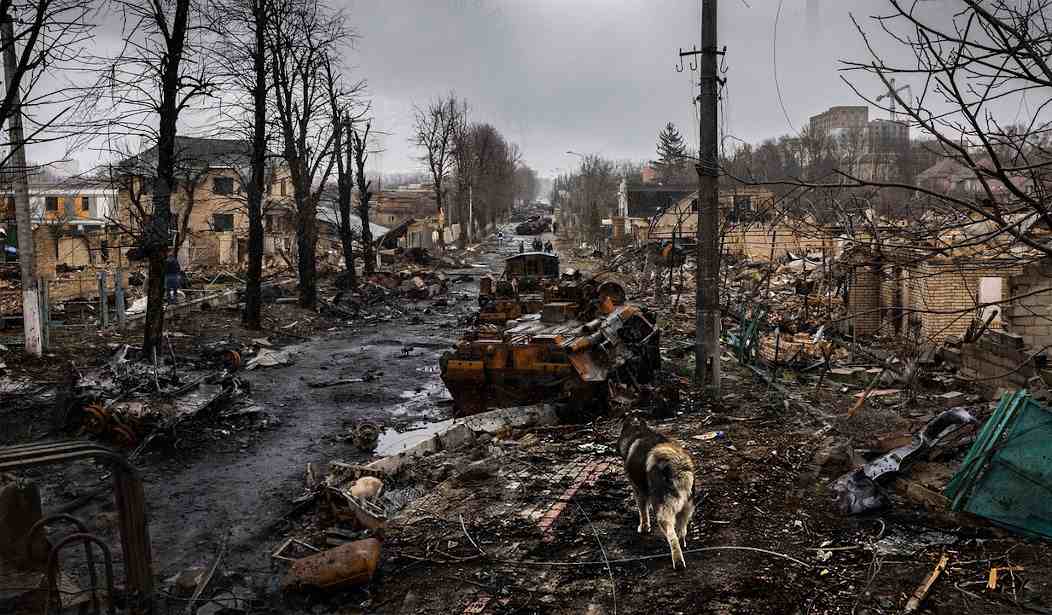
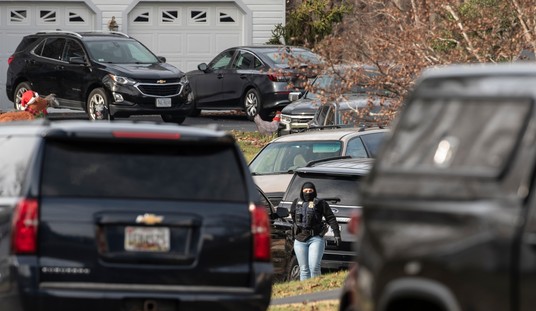


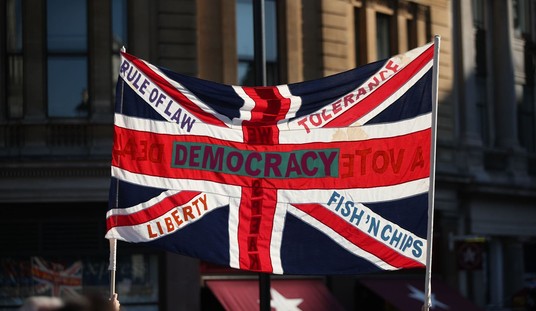
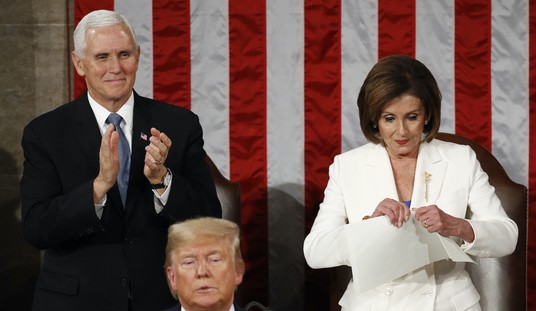

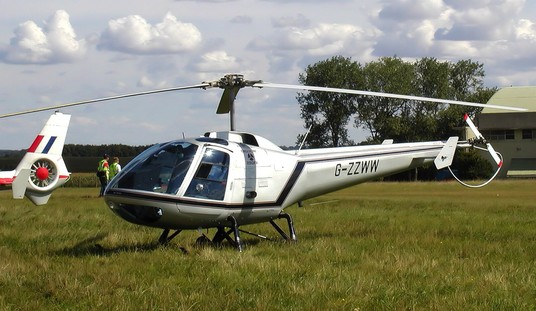




Join the conversation as a VIP Member